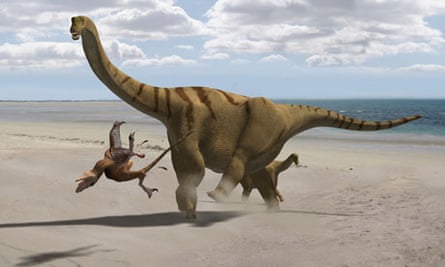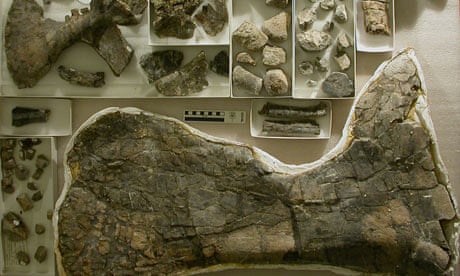"There is something fascinating about science," Mark Twain wrote. "One gets such wholesale returns of conjecture out of such a trifling investment of fact."
The question "how do they know that?" is always quick to arise in response to any scientific discovery, as the comments on any Guardian science article confirm. Quite right too. It's the key question that scientists should always ask, and always be ready to answer about their own work.
In my own science, palaeontology, that question looms large. Small animals can be quickly buried and fossilised, but larger corpses are more likely to be scavenged and broken up, or decompose. So the bigger the animals we study, the less fossils we generally get to work with. I work on the long-necked sauropods, the largest of all dinosaurs, which grew to 70 tonnes or more. The great majority of sauropod species are known from only a single specimen each, and most of these are horribly incomplete.
My own baby, Xenoposeidon, named in 2007, is based on part of a single vertebra , and there are plenty of others known only from similarly scanty remains. How can we know anything about an extinct animal when we work from so little evidence?
The discovery of our newest sauropod, Brontomerus mcintoshi, was announced last month. Happily it is based on more bones than Xenoposeidon, but still only about 10% of a whole skeleton. You might legitimately ask, how can we reconstruct an animal bigger than an elephant, and even speculate about its behaviour, when all we have is a set of bones that fits comfortably on a one-metre-square table?
First of all, the amount of a skeleton that you have can be misleading. The Brontomerus bones include a shoulder blade and a hip bone – only one of each, both from the left side – but because skeletons are symmetrical these bones convey as much information as if we had both the left and right versions. Similarly, we have one vertebra from the middle of the tail. The vertebrae do change along the tail, but the change is slow, so any given vertebra will be very similar to the few that were before and after it. We have only one complete rib, but that tells us something about the other ribs.
In theory, a skeleton that is less than 50% complete could tell you all there is to know about the animal.
The few preserved Brontomerus bones also give us an idea about the shape and size of the animal. By comparing these bones with those known from more complete sauropod skeletons, we can get some sense of where it fits into the family tree. And by comparing the size of our dinosaur bones with the analogous bones in related animals, we can get a broad sense of how big our beast was.
It can be a bit unnerving to see how precisely these imprecise estimates get reported, though. For example, our four attempts at estimates for the total mass of the animal yielded 4,666, 6,041, 6,300 and 9,563kg – an uncertainty factor of more than 2 – but this necessarily got condensed down to "around 6 tonnes" for the press release. Still, that's at least enough to know that it was roughly elephant-sized rather than cow-sized or whale-sized.
Many parts of the Brontomerus skeleton are completely missing – we have nothing at all from the skull, neck or limbs. Yet we named the dinosaur after its hind limbs – Brontomerus means "thunder thighs". How can we do that when we don't have any of the limb bones?
Because bones don't work in isolation. Animals' bodies are complex objects, and units of the skeleton work together. Hind limb function depends on the pelvis, the legs themselves and the tail, but if we have the pelvis (or in our case part of the pelvis), we can draw some conclusions about how the whole complex worked.
In this case, we have an ilium, the uppermost of the three bones that make up the pelvis and the one that most of the leg muscles attach to. (We can be confident that was true in dinosaurs because dissections of birds and crocodilians, their closest living relatives, show that these muscles work in broadly similar ways in both groups, forming an evolutionary bracket around dinosaurs.)
The ilium of Brontomerus tells us a lot. The lower margin of a dinosaur ilium forms part of the hip socket, and the upper part consists of a flattish plate of bone where muscles were anchored. In Brontomerus, the plate at the front of the ilium is hugely enlarged compared with other sauropods, so we deduce that the muscles that attached there were correspondingly enlarged. (These are called protractor muscles, and pull the leg forward.) The surprising aspect is that it's only the front part of the plate that's enlarged, while the part behind has shrunk down to almost nothing. Does this mean that Brontomerus had weak retractor muscles?
Not necessarily. Once again, comparisons with living animals come to the rescue. In crocs, the main retractor muscles attach not to the ilium but to the tail base, and details of the bones indicate that the same was true in dinosaurs. So it's possible that Brontomerus had extra-strong retractors as well as protractors. Unfortunately we don't know, because we have no vertebrae from the base of the tail.
So what were the large protractor muscles doing? If the retractors were not also enlarged, then the leg was optimised for being moved quickly forwards: in a word, kicking. In the absence of evidence for strong retractors, and especially in the light of a reduced attachment area for these muscles at the back of the ilium, kicking seems like the simplest and most likely explanation, so that's the angle that we played up in the media.

But the paper is more circumspect and also mentions several other possibilities. Perhaps Brontomerus was generally muscular and athletic? It's exciting to imagine it in a full-throttle, rhino-like gallop. Alternatively, the powerful muscles may have driven unusually long legs: Brontomerus might have appeared as a dinosaurian giraffe. Finally, the enlarged part of the ilium also anchors abductor muscles in living animals – muscles that draw the leg away from the midline, and which are important in bipedal standing and even walking. Could it possibly be that Brontomerus could rear up, or even walk on two legs?
If this discussion leaves you with the impression that we have more questions than answers, you're right. That 10% of the skeleton does tell us a lot – not least that it represents a new dinosaur, not a specimen of an old one. But it also leaves huge gaps in our understanding. The possibility that Brontomerus was athletic can't be evaluated without the tail base; the notion of long hind limbs requires the bones of the leg; and the idea of bipedality will remain speculation in the absence of fore limb fossils.
Physicists, chemists, and indeed zoologists who work on living animals, may be appalled at the level of speculation that necessarily goes into large-animal palaeontology. The best we can do is to maintain, as Douglas Adams put it, "rigidly defined areas of doubt and uncertainty".
In writing up fossils like Brontomerus, we have to be absolutely clear about the distinctions between data, reasonable inference, informed speculation, and sheer guesswork. Sometimes those distinctions are lost when we have to summarise the work in a two-minute radio interview, though even then we try to hedge our statements with phrases such as "it seems likely that ... " and "it make sense to think that ... " But the important thing is to be clear about data, inference and guesswork in communication with our fellow scientists.
One of the great things that has come out of the publication of Brontomerus is that plans are now afoot to go back to the quarry and look for more fossils. Nothing would be more exciting than to find more and better material of this dinosaur – maybe even the elusive complete skeleton. If that happens, we will find out whether Brontomerus really was a kicker or a galloper, or maybe a long-legged beauty.
We may find that we were wrong in some or even all of our informed guesses. Maybe even that the bones we thought belonged to Brontomerus are in fact from two different dinosaurs.
But that's OK: it's how science progresses. We do what we can with what we have, and hope that those who follow can do better with more.
Dr Mike Taylor is at the Department of Earth Sciences, University College London

Comments (…)
Sign in or create your Guardian account to join the discussion